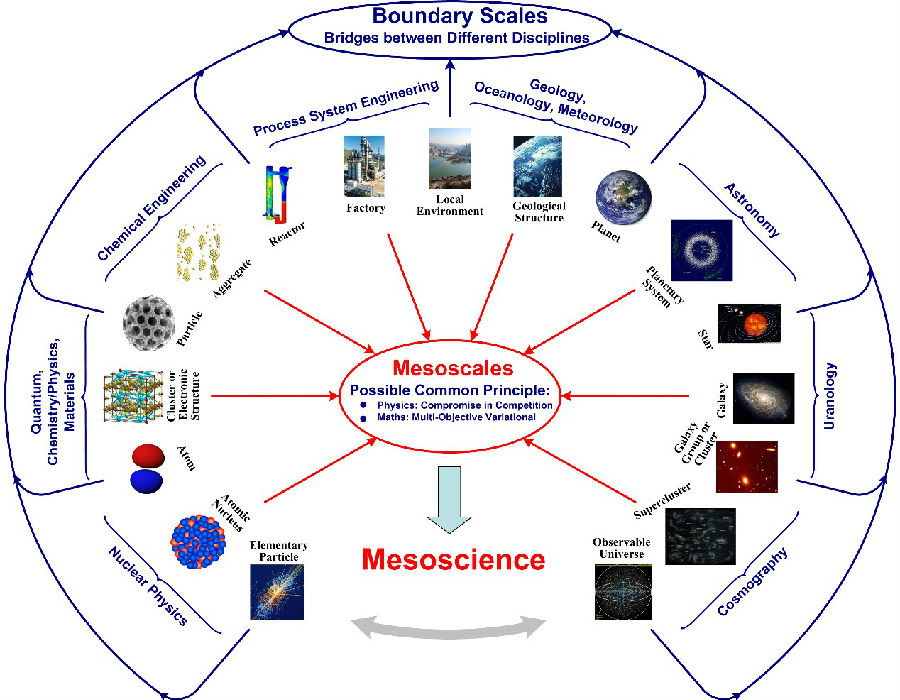You may complain about the unpredictability of the weather that spoiled your vacation, or wohhy about whether your job will be taken by highly intelligent robots in the near future, or whether the chemical plant near your residence is safe enough, but you may not realize that these seemingly unrelated problems may share a solution deeply rooted in an emerging science.
In fact, scientists in various areas have long been puzzled by mysterious missing links in their knowledge chains: No matter how much they know about the details of the systems they study and how familiar they are with the behavior of these systems, they know little about the complex structures usually present at the scale between the whole system and its elements. These structures may include violent tornados, weird neural networks, fluctuating reactant patterns, or many others. More to scientists’ surprise, structures in seemingly unrelated areas display intriguing complexities with some underlying similarities.
Describing, forecasting and manipulating such complexity is very challenging in almost all scientific disciplines and is the bottleneck in almost all industries. Is there a way to crack such a hard nut?
Chinese scientists are among many searching for answers and may have found a powerful tool. They have, for the first time, developed the concept of “mesoscience” – a methodology for discovering common principles governing all such complexity.
Models and computational paradigms derived from mesoscience have proved a success in chemical engineering and been quickly adopted by enterprises around the world, including TOTAL, BASF, Shell, BP, Sinopec, PetroChina, Baosteel and Unilever, to name a few.
However, mesoscience offers broad potential beyond the field of chemical engineering. “Mesocience is considered a general approach for tackling various complex systems in the real world and has an unprecedented future,” said LI Jinghai, member of the Chinese Academy of Sciences, who proposed the concept.
Mesoscience is attracting increasing attention from the world scientific community. Over 30 top scientists from the USA, UK, Australia, China, Germany, France, Switzerland, Italy, and Hungary are teaming up in Beijing for a three-day meeting from May 27-29 to focus on the future development and application of this new concept.
The participants are from many different disciplines, including chemistry, mathematics, psychology, and chemical engineering, etc. Many of them are members or fellows of prestigious national scientific organizations, as well as industrial researchers.
New challenging materials are emerging with superior and often multiple functionalities, such as battery materials, printing inks, catalysts, cosmetics or pharmaceutical formulations. “These kinds of materials have to be formulated on different levels ranging from molecular scale to particles in the micro-size regime,” said Bernd Sachweh, vice president of Chemical & Process Engineering Asia of BASF. “In order to achieve the targeted properties, the key process and reaction parameters often have to be controlled, especially in the mesoscale.”
Any object, large or small – from an elementary particle to a galaxy – can act as an element to form a system with many such elements. Mesoscale complexity exists widely and mesoscience can be applied widely as well. That is why it can help solve problems not solved by traditional methods.

Mesoscience focuses on complexity across a wide spectrum of systems (Image by HUANG Wenlai)
We see the world from the microscale to the macroscale. Traditional theories have been used to tackle macroscale or microscale problems, thus dividing scientists into the two camps of holism and reductionism. However, there are unknown gaps between individual elements and system behavior, as reflected in the saying: “The whole is greater than the sum of its parts.” The key point lies in the mesoscale, or interactions between elements of the system.
“[Mesoscience] provides common principles to consider in S&T to respond to grand challenges with advanced high level research solutions,” said Professor Augusta Maria Paci from the National Research Council of Italy.
“Mesoscience not only has far-reaching scientific implications but also wide industrial significance,” said GE Wei, director of the Mesoscience Research Division of the Institute of Process Engineering, Chinese Academy of Sciences. “It has been found to be a key to addressing the long-lasting scaling problems that lie between laboratory apparatuses and commercial facilities.”
"This approach should be adopted not only in scientific research, but also in training next generation,” said Professor Raffaella Ocone, Fellow of the Royal Academy of Engineering. Yet "more work is required in this area in order to sway the wider scientific community,” said Robin Batterham, former president of Austrilian Academy of Technological Science and Engineering.




